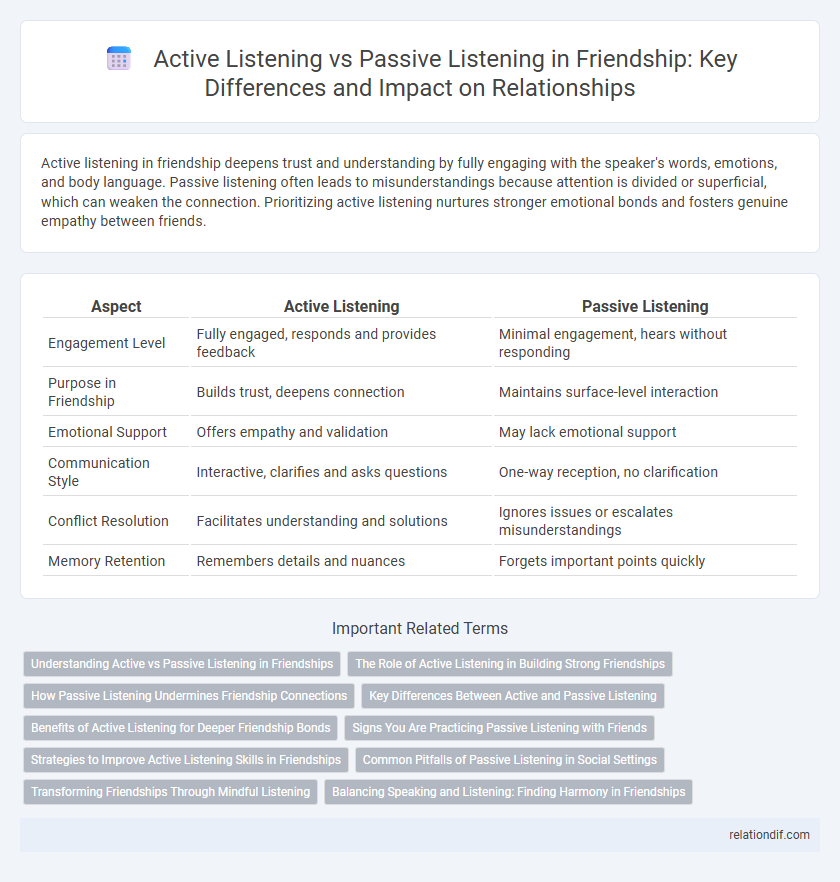Active listening in friendship deepens trust and understanding by fully engaging with the speaker's words, emotions, and body language. Passive listening often leads to misunderstandings because attention is divided or superficial, which can weaken the connection. Prioritizing active listening nurtures stronger emotional bonds and fosters genuine empathy between friends.
Table of Comparison
| Aspect | Active Listening | Passive Listening |
|---|---|---|
| Engagement Level | Fully engaged, responds and provides feedback | Minimal engagement, hears without responding |
| Purpose in Friendship | Builds trust, deepens connection | Maintains surface-level interaction |
| Emotional Support | Offers empathy and validation | May lack emotional support |
| Communication Style | Interactive, clarifies and asks questions | One-way reception, no clarification |
| Conflict Resolution | Facilitates understanding and solutions | Ignores issues or escalates misunderstandings |
| Memory Retention | Remembers details and nuances | Forgets important points quickly |
Understanding Active vs Passive Listening in Friendships
Active listening in friendships involves fully engaging with the speaker through eye contact, nodding, and providing feedback, which deepens emotional connection and trust. Passive listening, on the other hand, means hearing words without meaningful interaction or response, often leading to misunderstandings and weaker bonds. Prioritizing active listening enhances empathy and clarity, making friendships more resilient and supportive.
The Role of Active Listening in Building Strong Friendships
Active listening fosters trust and empathy by fully engaging with a friend's words, emotions, and nonverbal cues, creating a deeper emotional connection. Unlike passive listening, which often leads to misunderstandings and weakened bonds, active listening encourages open communication and mutual support. Neuroscientific studies show that active listening activates brain areas associated with social cognition, enhancing relationship satisfaction and long-term friendship stability.
How Passive Listening Undermines Friendship Connections
Passive listening in friendships often leads to misunderstandings and emotional distance, as it signals a lack of genuine interest or empathy toward the speaker's feelings and experiences. When one party consistently fails to engage actively, the trust and openness essential for deep connections deteriorate, reducing the relationship to superficial exchanges. Active listening practices, including reflective feedback and validating emotions, reinforce bonds by ensuring friends feel heard and valued.
Key Differences Between Active and Passive Listening
Active listening in friendship involves fully engaging with the speaker through eye contact, feedback, and empathetic responses, which fosters trust and deeper understanding. Passive listening, on the other hand, entails hearing words without providing meaningful feedback or emotional involvement, often leading to misunderstandings or feelings of neglect. Key differences include the level of attention, emotional connection, and responsiveness that strengthen or weaken the bond between friends.
Benefits of Active Listening for Deeper Friendship Bonds
Active listening strengthens friendship bonds by fostering trust and empathy, allowing friends to feel genuinely understood and valued. Engaging fully in conversations helps uncover underlying emotions and thoughts, promoting deeper emotional connections. This attentive communication reduces misunderstandings and builds a foundation for lasting, meaningful relationships.
Signs You Are Practicing Passive Listening with Friends
Signs you are practicing passive listening with friends include frequently interrupting or thinking about your response instead of fully hearing their words, showing minimal eye contact, and failing to ask follow-up questions that demonstrate genuine interest. Passive listening often results in missing emotional cues and subtle messages, causing misunderstandings and weakening the trust in the friendship. Recognizing these behaviors helps improve communication and strengthens the bond between friends.
Strategies to Improve Active Listening Skills in Friendships
Effective active listening in friendships involves maintaining eye contact, providing feedback through nodding or verbal affirmations, and avoiding distractions such as phones or background noise. Asking open-ended questions encourages deeper conversations and demonstrates genuine interest, strengthening emotional bonds. Practicing empathy by reflecting feelings and summarizing key points helps friends feel valued and understood, promoting trust and connection.
Common Pitfalls of Passive Listening in Social Settings
Passive listening in social settings often leads to misunderstandings, as individuals miss critical emotional cues and nonverbal signals essential for effective communication in friendships. This inattentiveness can cause feelings of neglect or disinterest, weakening the trust and emotional connection between friends. Overcoming common pitfalls of passive listening by engaging in active listening fosters deeper bonds and prevents conflicts.
Transforming Friendships Through Mindful Listening
Mindful listening transforms friendships by fostering genuine connection and understanding through active engagement, which involves attentively processing and responding to a friend's emotions and words. Unlike passive listening, which often leads to misunderstandings and emotional distance, active listening strengthens trust and empathy by validating feelings and encouraging open communication. Embracing mindful listening techniques cultivates deeper bonds and resilience in friendships.
Balancing Speaking and Listening: Finding Harmony in Friendships
Balancing speaking and listening in friendships requires mastering active listening, which involves fully engaging with and responding to a friend's thoughts and emotions, rather than passively hearing their words. Active listening builds trust, deepens understanding, and fosters emotional connection, while passive listening often leads to misunderstandings and weakened bonds. Prioritizing meaningful dialogue through attentive interaction creates harmony and strengthens the foundation of lasting friendships.
active listening vs passive listening Infographic

 relationdif.com
relationdif.com